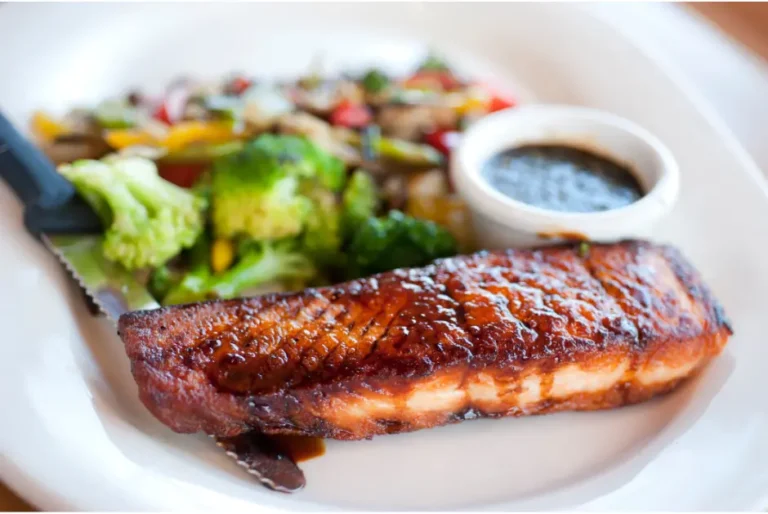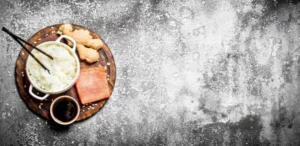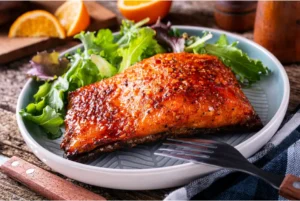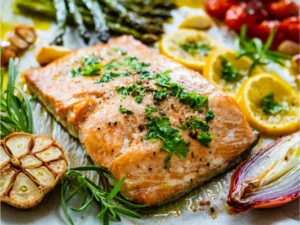Salmon is a beloved seafood, known for its rich taste and numerous health benefits. But have you ever tried Ginger Dill Salmon? This delectable dish combines the goodness of salmon with the unique flavors of ginger and dill. In this article, we’ll explore the world of Ginger Dill Salmon, from its preparation to its rich history and health benefits. So, let’s dive in and discover the wonders of this culinary delight.
Introduction to Ginger Dill Salmon
Let me paint you a picture: imagine a mouth-watering, flaky salmon fillet, marinated and glazed with a tangy, slightly sweet ginger dill sauce. You can almost smell the intoxicating aroma wafting from the oven, can’t you? This easy peasy recipe does all the talking at the dinner table while you can take all the bowing.
Health benefits of consuming salmon
Before we delve into the details of Ginger Dill Salmon, it’s essential to highlight the health benefits of salmon itself. Salmon is packed with omega-3 fatty acids, which are known to promote heart health, reduce inflammation, and enhance brain function. Additionally, salmon is an excellent source of high-quality protein and is rich in essential vitamins and minerals.
Why ginger and dill are perfect pairings with salmon
Ginger and dill are two distinct ingredients that, when combined, create a harmonious blend of flavors. Ginger adds a hint of spiciness and warmth, while dill contributes a fresh and slightly tangy taste. Together, they complement the mildness of salmon, making it a delightful dish for the palate.
Essential Ingredients for Ginger Dill Salmon
Detailed list of ingredients
Ready to unleash the inner chef in you? You’ll need fresh salmon fillets, ginger, dill, honey, lemon juice, garlic cloves, salt, and pepper. Eight ingredients, that’s it. Seems like mission impossible, but believe in yourself, as I do!
Role of each ingredient in enhancing taste and health
Every ingredient in this dance of flavours moves like a pro. The salmon offers the royally rich canvas, the ginger and garlic come forth like the rhythm section of a band, striking all the right notes and the honey, oh the honey! It provides just enough sweetness to balance the dish. All the while, lemon juice makes sure it doesn’t get too sweet – a lifesaver, like the guy who turns off the mic when your uncle starts singing at a party.
Possible ingredient substitutions
Here’s a little secret: super cool chefs like us are not afraid of substitutions. No honey? Use maple syrup. Allergic to dill? Try parsley or thyme. Can’t find salmon? Trout can equally steal the show. Remember, rules are meant to be “tweaked” in the kitchen!
Step-by-Step Guide to Preparing Ginger Dill Salmon
Comprehensive guide on how to prepare the salmon
Alright, let’s dive in. Drizzle your salmon fillets with lemon juice, ginger, garlic, and honey. Sprinkle with dill, salt, and pepper. Heat your oven to a toasty 375°F (190°C) and let these babies roast for about 20 minutes. But hey! Every oven is different, so make sure to check on it.
Detailed instructions for the ginger dill marinade
Tip-toe into your pantry. Sneak out the ginger, dill, lemon juice, honey, dill, and garlic. Whisk them together until they form a beautiful, golden elixir. Remember, it’s not just a marinade; it’s the secret potion that’s going to change your salmon eating game forever.
Time-saving tips and common pitfalls to avoid during preparation
Always remember: over-marination equals fish “mushification.” Sounds gross, right? So, stick to marinating the salmon for no more than 30 minutes in the fridge. Also, keep that oven heat consistent. If you peak too often, you might dry out your salmon, making it as dry as Death Valley.
How to Serve and Pair Ginger Dill Salmon
Description of the best ways to serve the dish
Try serving this Ginger Dill Salmon over a bed of fluffy rice with a side of grilled vegetables. The colourful, vibrant plate could easily be mistaken for a Picasso painting. It’s just that beautiful!
Sides that pair well with the ginger dill salmon
A fresh salad, some roasted next-level potatoes, or even just some good old green beans can go a long way in complementing your masterpiece. The key here lies in not letting your side dish overshadow the star of the night – your Ginger Dill Salmon… obviously!
Drink suggestions to complete the meal
I’d recommend a crisp, light white wine, perhaps a Sauvignon Blanc to enhance the flavours but not overpower them. Not a wine enthusiast? Even an ice-cold beer could be your salmon’s best friend. Golden ale pairs really well with seafood, or even a citrusy IPA. Responsible drinking is always fancy.
Tips to Store and Reheat Ginger Dill Salmon
Guidance on how to properly store leftovers
Let your Ginger Dill Salmon swim into an airtight container and shove it into the fridge once it cools down. Trust me, this will keep the taste intact and keep things less fishy. (Catch that pun?)
Tips for reheating and ensuring the least possible loss of flavour
Reheating fish can be as tricky as tying a bowtie with one hand. Preheat your oven to about 275°F (135°C), cover the dish with foil to keep the moisture in, and gently reheat it for 15-20 minutes.
How long the dish can stay fresh in the fridge and freezer
Your cooked salmon can happily stay in the fridge for up to 3 days. In the freezer, though, it could survive for up to 4 months. Remember to say hello to it often. Loneliness can be terrible in the icy lands of freezer-ville.
We’ve covered quite a bit, haven’t we? From the magical fusion of ginger and dill with salmon, the importance of each ingredient to the finesse of reheating. We’ve gone from novice fish cooks to salmon experts, and I couldn’t be prouder.
Sharing personal experiences and findings related to the recipe
Between you and me, the first time I made this salmon, it turned out unexciting. I realized the key is not to overcook or over-marinate, just let the ingredients do their job. Also, the first bite of the dish directly took me to palate paradise.
Encouragement for readers to try the recipe and share their experiences
I dare you to try this Ginger Dill Salmon recipe and share your experiences. After all, life’s a kitchen, put on your prettiest apron, and whip up something incredible!
Can you substitute the salmon with another type of fish?
Yes, you can substitute salmon with various other types of fish in many recipes. The choice of fish will depend on your personal preferences, the recipe you’re preparing, and the flavor and texture you desire. Here are some common alternatives to salmon:
- Trout: Rainbow trout or brown trout are often used as substitutes for salmon, as they have a similar texture and flavor.
- Arctic Char: Arctic char is related to salmon and trout and has a mild, buttery flavor.
- Steelhead Trout: Steelhead trout is another salmonid fish that closely resembles salmon in taste and texture.
- Sea Bass: Sea bass, such as Chilean sea bass or European sea bass, can be a good substitute, especially in recipes that call for grilling or baking.
- Halibut: Halibut has a firm, white flesh that is quite different from salmon but works well in various recipes, especially when you want a milder fish flavor.
- Mahi-Mahi: Mahi-mahi has a firmer texture and a slightly sweet flavor, making it suitable for grilling or pan-searing.
- Tuna: Yellowfin or albacore tuna can be used as a substitute in some recipes, but they have a distinct flavor and may not work well in all salmon recipes.
- Cod: Cod is a flaky white fish with a mild flavor, making it a good substitute for salmon in recipes that don’t require a strong fish taste.
Remember that the cooking method and seasonings you use can also impact how well a substitute fish works in a particular dish. When substituting one fish for another, consider the texture and flavor of the fish and how it will complement the other ingredients in your recipe
How long should I marinate the fish?
About 30 minutes should do the trick. Anything more and you’re heading towards the dreaded ‘mushy fish’ territory.
What can be used in place of fresh dill?
If dill isn’t your thing, don’t fret! You can use fresh parsley, thyme, or even basil to mix it up a bit.
How to know when the salmon is cooked properly?
Look for opaqueness and easy flaking when you press it with a fork. “Transparent and tough” pretty much means “put me back, I’m not baked enough.”
Can this recipe be prepared in a slow cooker or Instant Pot?
Unfortunately, this recipe doesn’t ideally fit into a slow cooker or an Instant Pot programme. But don’t lose heart, the good old oven never goes out of style.




